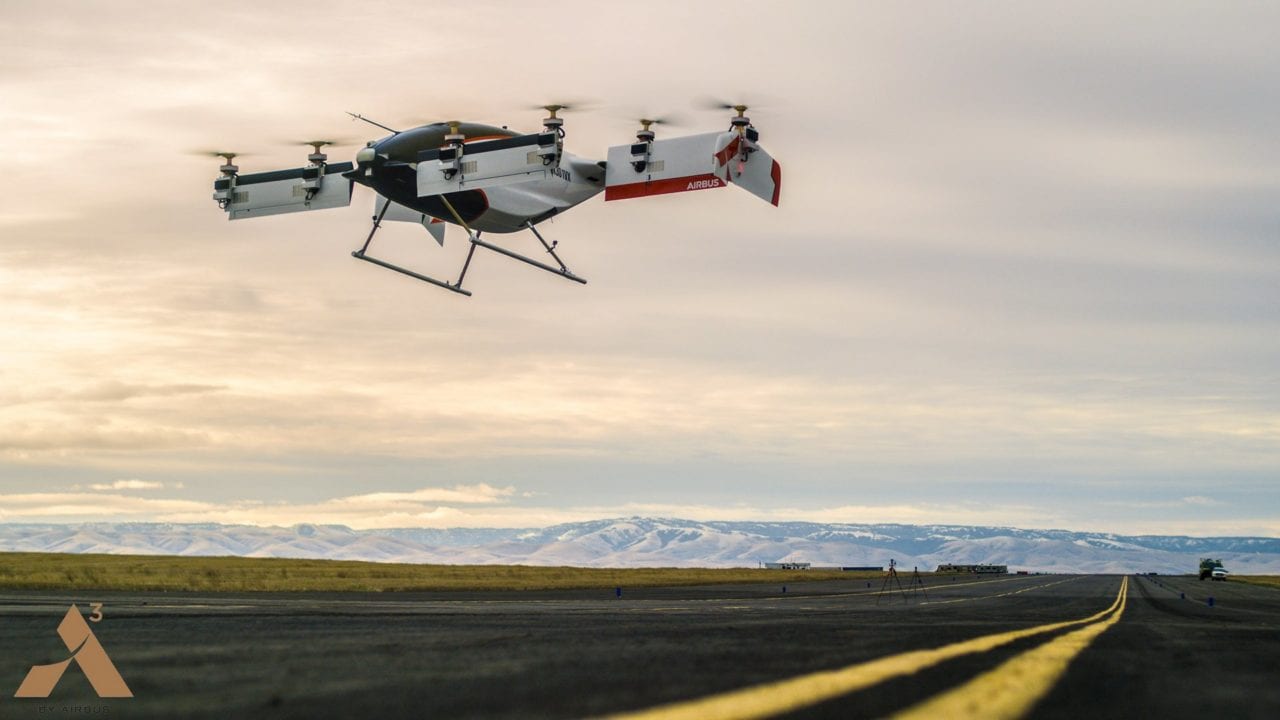
Airbus A³’s Vahana is slated to complete its flight test portfolio by the end of 2019. (Airbus)
Airbus A³’s Vahana demonstrator aircraft, which has been flying since January 2018, recently completed its 100th test flight and is on track to complete its test flight portfolio by the end of 2019, according to the company. The Pendleton, Oregon-based testing team recently published an in-depth look at their test flight operations.
The all-electric, autonomous Alpha One demonstrator has been following pre-programmed routes around a racetrack to test operational limits of the aircraft, gradually expanding its operating envelope.
In order to perform multiple test flights per day, the Vahana’s two 300-pound lithium-ion batteries are designed to be swappable “in less than 10 minutes,” according to the Vahana test team. The batteries are then charged off-aircraft with a charging station normally used for electric cars; it takes roughly an hour to charge the Vahana’s batteries after a flight via this method.
“In the long term, fast charging (10 minutes or less) is clearly preferable since it requires less labor and support equipment, but we feel that battery technology as it stands today is not quite there,” Zach Lovering, vice president of urban air mobility systems at Airbus A³, told Avionics International. “Fast charging reduces battery life, which in turn increases the costs that must be covered by the end user. Battery swapping enables fast turn around times at the test pad using existing technologies and is therefore a feature being considered for future products.”

Vahana’s two 300-pound lithium ion batteries slide into the vehicle on rails. (Airbus)
The experimental aircraft follows predefined flight plans, defined “as a series of small segments with the desired vehicle state including position and speed,” head of flight testing Matt Deal and test engineer Nico Kokocinski wrote in a blog post on October 10. “All flight plans are validated with nonlinear simulation, hardware-in-the-loop simulation, Monte Carlo simulation, and subscale demonstration prior to being flown on the full-scale aircraft.”
Lovering confirmed to Avionics that no decision-making is done on the aircraft at this time, with all contingency paths also pre-defined so the test team has an expectation of the vehicle’s behavior in the event of a contingency at any point during the flight.

A sample flight plan. Vahana recently completed its 100th test flight. (Airbus)
“The vehicle carries a sense and avoid system which is actively collecting data to enable real-time generated trajectory deviations to avoid obstacles in flight,” Lovering said. “However, it will remain a passive data collection payload while the vehicle performance envelope is being evaluation.”
Lovering said the Vahana demonstrator project “will complete all deliverables in 2019,” including its flight test campaign.
“Vahana has provided critical insight into autonomy capabilities and overall performance of a tilt-wing configuration,” he said. “Learnings from both aircraft — Vahana and CityAirbus — will be used to advance our relationship with regulators and understanding of key technologies. Engineers from both demonstrator teams and elsewhere in the company are working together to envision and develop the future Airbus Urban Mobility vehicle.”
Check out footage of a Vahana test flight, uploaded to to the company’s blog:
 | Want more eVTOL and air taxi news? Sign up for our brand new e-letter, “The Skyport,” where every other week you’ll find the most important analysis and insider scoops from the urban air mobility world. |